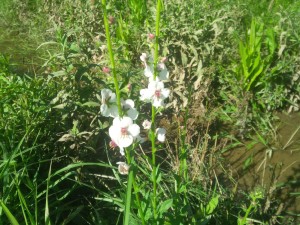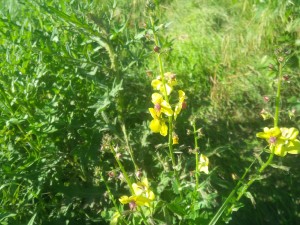
I am not an orchid person, but from time to time I fall madly in love with plants that bear orchid-like flowers. Sweet peas beguile me, though I have never had success growing them in the garden. I blame that on climate, though inattention might also play a role.
Every year in early summer I renew my love affair with a beautiful, but somewhat dangerous orchid imposter—moth mullein or Verbascum blattaria. If you drive on country roads in July, you have probably breezed right by stands of moth mullein growing just off the highway shoulder. Sightings are especially likely along the sides of county roads where mowing is infrequent. Most of us do not have occasion to frequent the edges of farm fields, but moth mullein also like these spaces between cultivated acreage and old-fashioned hedgerows.
Moth mullein flowers, which appear at the tops of the stalks, are either white or yellow. The white flowers appear as purple-pink buds and have a slight purple cast when fully open. They are the most reminiscent of orchids, looking like smaller editions of the common moth orchid—Phalaenopsis—available by the tens of thousands at retail establishments everywhere. Yellow-flowered moth mulleins also bear purplish buds, but that color is less noticeable when the bright yellow blooms are fully open. Both types feature five-petaled flowers with centers dominated by flashy orange stamens accented with purple hairs. Some sources say that these stamens resemble moth antennae, giving rise to the plant’s common name. Most references attribute the “moth” nickname to the flower configuration.
Depending on location, the plants are between one and three feet tall, rising from a basal rosette of elongated oval leaves with toothed edges. The leaf rosettes appear the first year, with the flower stalks leaping upward the second year, marking moth mullein as a biennial plant. Up close, the flowering stalks are somewhat hairy. Moth mulleins are part of the same Verbascum genus as giant mullein, that tall, yellow-flowered stalwart of roadside verges and other untenanted locales that old-fashioned garden writers used to call “waste spaces.” I prefer the delicate appearance of the “moths” to the coarse, but spectacular height and color of the giant mulleins.
So, what makes these wayside beauties so dangerous? One word—success. Native to Europe, western Asia and north Africa, Verbascum blattaria was first described in the United States in 1818. Since then, mulleins have made themselves completely at home in every state except Alaska, not to mention parts of Canada. Multiplying by vigorous self-seeding, the plants have been able to out-compete natives in some places. Colorado has put them on its “noxious weeds” list, but moth mulleins are most populous in the Northeast.
I would never deliberately scatter moth mullein seeds or plant them in my home garden, but the flowers are so beautiful that I can’t help viewing them as natural marvels when I see them by the side of the road. I have often considered trying to find better-mannered look-alike plants for my ornamental borders. The best choices are Verbascum chaixii ‘Sixteen Candles’, with yellow flowers or Verbascum ‘Southern Charm’, featuring pink-tinged white blooms. Both are perennials, rather than biennials and boast even more blooms than their blattaria cousins. Like moth mulleins, they prefer sunny spots, but are not fussy about other conditions and even seem to prefer rather poor soil. A happy domesticated mullein, like its wild cousin, will self-seed.
You can find both verbascums at good garden centers and nurseries, or you can buy from catalog/online vendors. One good source is Bluestone Perennials, 7211 Middle Ridge Rd. Madison, OH 44057; (800) 852-5243; www.bluestoneperennials.com. Free print catalog.
Moth mulleins may be classed as “noxious weeds” in some quarters, but like many noxious things, they are not without redeeming qualities. Plant parts have been used as an effective cockroach repellant for centuries. The species name, “blattaria” is even derived from the Latin word “blatta” meaning “cockroach”. As wildflowers they may be problematic, but as a roach repellant, moth mullein probably falls into the much-praised “all natural” or at least “relatively benign” category.

